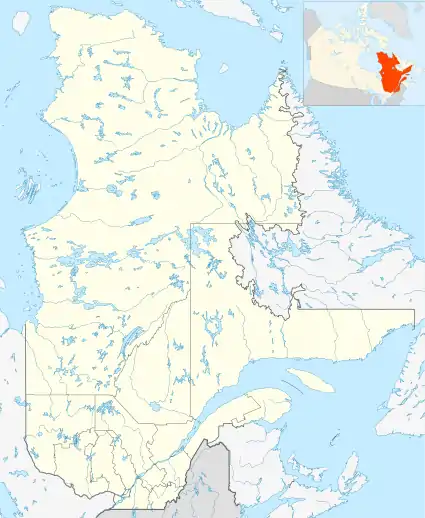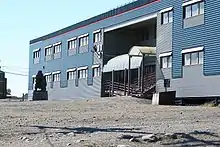Puvirnituq
Puvirnituq (Inuktitut: ᐳᕕᕐᓂᑐᖅ) is a northern village (Inuit community) in Nunavik, on the Povungnituk River near its mouth on Hudson Bay in northern Quebec, Canada. Its population was 1,779 as of the Canada 2016 Census.[3]
Puvirnituq
ᐳᕕᕐᓂᑐᖅ | |
|---|---|
 | |
 Puvirnituq | |
| Coordinates: 60°02′N 077°16′W[1] | |
| Country | Canada |
| Province | Quebec |
| Region | Nord-du-Québec Nunavik |
| TE | Kativik |
| Constituted | September 2, 1989 |
| Government | |
| • Mayor | Lucy Qalingo Aupalu |
| • Federal riding | Abitibi—Baie-James—Nunavik—Eeyou |
| • Prov. riding | Ungava |
| Area | |
| • Total | 111.50 km2 (43.05 sq mi) |
| • Land | 86.3 km2 (33.3 sq mi) |
| Population (2016)[3] | |
| • Total | 1,779 |
| • Density | 20.6/km2 (53/sq mi) |
| • Change (2011–16) | |
| • Dwellings | 450 |
| Time zone | UTC−05:00 (EST) |
| • Summer (DST) | UTC−04:00 (EDT) |
| Postal code(s) | J0M 1P0 |
| Area code(s) | 819 |
| Website | www |
Unlike most other northern villages in Nunavik, it has no Inuit reserved land of the same name associated with it.
The name means "Place where there is a smell of rotten meat". This unusual name may have originated from either one of these events (occurring a long time ago):
- A herd of caribou was swept away by the Povungnituk River while attempting to cross it and washed ashore near the current village site where the decomposing bodies began giving off a staunch smell.
- An epidemic killed off most of the area's residents to the point where there were not enough people to bury the dead, allowing the exposed bodies to decompose, giving off a putrid smell.
Puvirnituq is the aviation hub of the Hudson Bay coast. Puvirnituq Airport handles scheduled flights to and from all other Hudson Bay coastal communities in Quebec, Montreal, and Ottawa. It is not accessible by road.
The police services in Puvirnituq are provided by the Kativik Regional Police Force.[4]
History
In 1921, the Hudson's Bay Company established a trading post here, known as Povungnituk and often shortened to Pov. This attracted the settlement of Inuit living in the region. In 1951, the HBC opened a general store. The closure of HBC stores in other nearby villages led to an influx of Inuit to Puvirnituq.
A Catholic mission was founded in 1956, which encouraged the residents to form the Carvers Association of Povungnituk two years later. It later became the Co-operative Association of Povungnituk and was instrumental in assisting, developing, and marketing Inuit art. Its success inspired other Inuit communities to form similar cooperatives, most of which now make up the Federation of Co-operatives of Northern Quebec. Leah Nuvalinga Qumaluk was among the artists who worked at the cooperative.[5]
Education

The Kativik School Board operates the Iguarsivik School.[6]
Gallery
 Hospital
Hospital General store
General store View of Puvirnituq River
View of Puvirnituq River Street view in winter
Street view in winter The village near the North bank of Puvirnituq River
The village near the North bank of Puvirnituq River Cemetery of Puvirnituq
Cemetery of Puvirnituq
References
- Reference number 291472 of the Commission de toponymie du Québec (in French)
- Geographic code 99120 in the official Répertoire des municipalités (in French)
- "Census Profile, 2016 Census". 2016 Census. Statistics Canada.
- KRPF. "General Information". Home. Retrieved 2017-07-03.
- Jules Heller; Nancy G. Heller (19 December 2013). North American Women Artists of the Twentieth Century: A Biographical Dictionary. Routledge. ISBN 978-1-135-63882-5.
- "Our Schools." Kativik School Board. Retrieved on September 23, 2017.
External links
| Wikimedia Commons has media related to Puvirnituq. |
